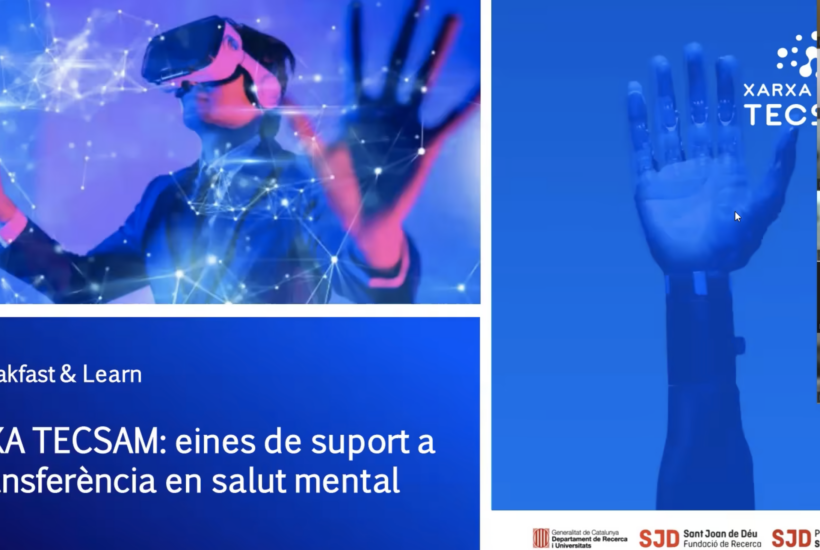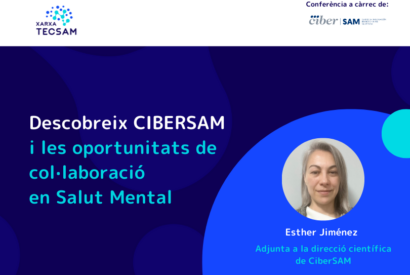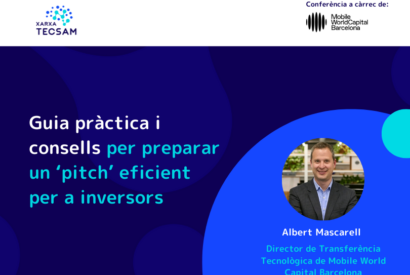Network tools for knowledge transfer
What is knowledge transfer? Learn about the step-by-step path to transferring solutions and the Network's support tools to make it possible.

In the XIV B&L we have addressed the challenges and the Network’s support tools for transferring knowledge and technology, in the broadest sense, to society and people.
Apart from technology and innovative solutions, the knowledge and scientific findings provided by mental health researchers are also potentially transferable to society and are key to addressing social needs. This was one of the reflections of the first virtual meeting of this year’s Breakfast&Learn, aimed at learning about the step-by-step process of transfer and the tools available on the Network in each of these phases.
“The value generated within a research group can be presented in the form of knowledge and experience, which are also transferable,” said Desirée Gutiérrez, innovation technician at the TECSAM Network, and speaker, together with Iris Mauricio, head of communication, at this 14th B&L, given for the first time by the Network’s team.
The transfer of research results (and not necessarily of technology) is an approach rarely contemplated by the research community and which, on the contrary, in the Network has a great weight in the way in which transfer is understood, a process that goes far beyond the business vision and, therefore, beyond the commercialisation of an exploitable and profitable solution.
With this holistic approach, the aim has been to guide the public through the 4 phases of transfer by providing them with the specific mechanisms that we have in the Network, some exclusive to the member groups that are part of it, and others open to the mental health innovation ecosystem in general. The Network can be an ally to enable technology and research results to reach the market, but above all to bring them closer to the affected people.
Defining the idea
Thus, the generation of value starts from the conceptualisation of the idea, when unmet needs are identified and an attempt is made to address them in some way, either from basic research (with a paper) or with a technological device or software that has the potential to be introduced and applied in society. Therefore, all research groups have the capacity to transfer innovations and add value from the outset. This is what we call the culture of innovation.
Protection and regulation of the idea
Most researchers encounter problems in terms of protection and regulation of a solution once the idea has been defined, such as intellectual property, trade secrets, patents or the regulations that apply to medical devices. In this sense, it is key to define a “good protection strategy to reinforce the exploitation and commercial interest”, according to González, in the case of wanting to move towards commercialisation.
The Network offers transversal tools that can be useful from the first phase, such as the portfolio of innovative solutions of the research groups, a compendium of all the knowledge and technology existing in the Network; or the Programs, an exclusive resource for the member groups through which we can finance expert advice on business ideas or regulatory issues, among others.
Entrepreneurship and business model
Gutiérrez also highlighted the need to open our mind to the process of entrepreneurship and the introduction of a solution on the market, as there are many non-commercial ways of transferring knowledge through scientific publications, teaching and dissemination through congresses and seminars for professionals and associations of affected people, informal exchanges, etc.
However, the speaker also stressed that, contrary to what researchers think, everything is potentially transferable. Therefore, any scientific finding can be commercialised through contracts and consultancy agreements, licensing and technology transfer, or the creation of a spin-off.
In this line, Mauricio mentioned the plurality of tools for this third phase of entrepreneurship, as well as in the rest of the phases. For example, the transversality of the Breakfast&Learn, a tool open to the entire ecosystem that offers totally free training to broaden knowledge on topics that encompass each and every one of the phases of the transfer process.
Sustainability and exploitation
The fourth and final phase is sustainability, which refers to the ability to maintain a project over time, and often requires seeking partners or external support and investors. In this respect, the Network also offers support through the active search for potential collaborating agents, the promotion of projects through its communication channels or the organisation of events to find partners. Thus, the Network’s human resources become a differentiating and central element in the Network’s philosophy and action plan.
In this virtual session, under the name “TECSAM Network: from research to transfer”, Mauricio also explained the raison d’être of the Network, as well as its objectives and transversal axes, specifically, gender equality and the inclusion of affected people in each and every one of the Network’s actions.
The attendees were also able to learn first-hand about the roadmap and calendar of activities planned for the Network this year and for the coming years on the occasion of the recognition of the Network as one of the 11 R+D+i networks by the Generalitat de Catalunya, something that will make possible to continue its activity until at least 2025.
You can consult the complete presentation in this link.

